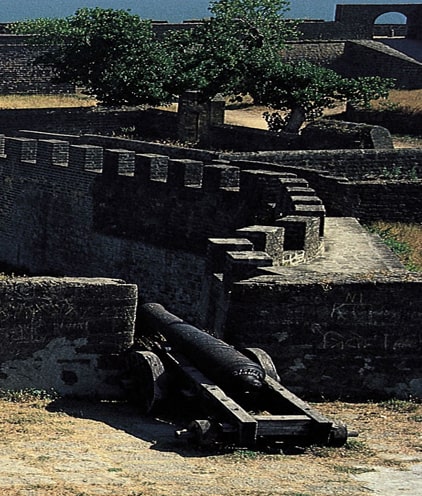Daman and Diu, a union territory in west India, consists of 2 separate areas divided by the Arabian Sea. The Daman Ganga River flows through the coastal town of Daman. Diu is a small island and mainland village. The Fort of Moti Daman, Diu Fort and 16th-century churches reflect the territory’s past as a Portuguese colony. In the town of Moti Daman.

The massive Fort that runs round the settlement like a girdle, dates back to 1559 AD. This structure in the present form encompasses about 30,000 sq. mts. with 10 bastions and two gateways. The fort is protected by a moat on the land side and also connects the river to the sea. It is basically polygonal in plan with projections at regular intervals of about 500 feet and carrying splayed angular bastions. The parapet above the fortification walls is without merinos but is provided with loop holes. The terraces close to the top of the wall are connected to the inner ground surface by open flight of steps at many places. All along the inner wall, there are barracks for defence personals. The inscription above the southern (land) gate mentions that this gate along with the bastions adjacent to it was completed in 1581 AD after the Mughal invasion in Akbar's reign. The inscription on the Northern (sea) gate gives the date of 1593 AD for the completion of the Fort wall. On the Northern side within the palaces, the Secretariat and other official buildings. A large number of Portuguese gentry and their families reside within the Fort.



The nearest airports to Daman are Mumbai (170 km) and Surat (90 km). Flights are easily available for Mumbai from all the major airports of the country. Surat is connected by flight from Delhi. The nearest international airport is in Mumbai.
Lorem ipsum, or lipsum as it is sometimes known, is dummy text used in laying out print, graphic or web designs. The passage is attributed to an unknown typesetter in the 15th century who is thought to have scrambled parts of Cicero's De Finibus Bonorum et Malorum for use in a type specimen book.
Lorem ipsum, or lipsum as it is sometimes known, is dummy text used in laying out print, graphic or web designs. The passage is attributed to an unknown typesetter in the 15th century who is thought to have scrambled parts of Cicero's De Finibus Bonorum et Malorum for use in a type specimen book.